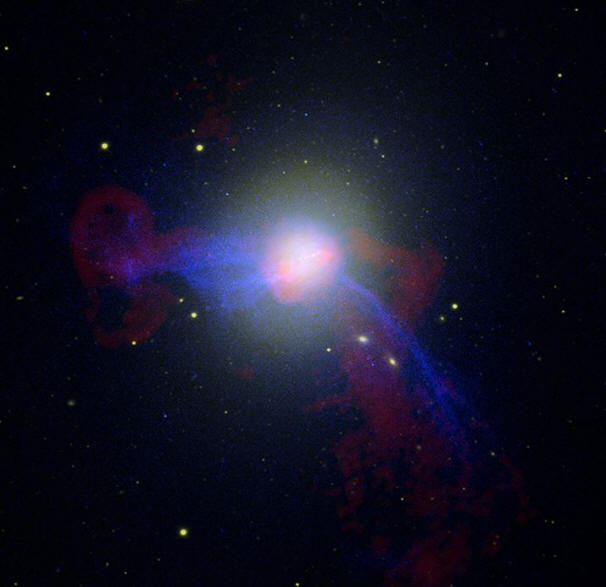
home •
about •
essential guide •
picture of the day •
thunderblogs •
news •
multimedia •
predictions •
products •
get involved •
contact
picture of the day archive subject index
Credit: X-ray: NASA/CXC/CfA/W. Forman et al.; Radio: NRAO/AUI/NSF/W. Cotton;
Optical: NASA/ESA/Hubble Heritage Team (STScI/AURA), and R. Gendler
Aug 08, 2008
The Braided Filaments of Galaxy M87The electrical nature of the first "galactic jet" observed by Curtis in 1918 has been confirmed once again.
Recent Chandra X-ray Observatory composite images of M87, a large active galaxy in the Virgo Cluster, have revealed the braided, filamentary nature of its "jet." Such braiding is the signature of Birkeland currents in space. Electromagnetic forces pinch the current channels into long filaments in defiance of gravity and gas laws.
Multiple currents attract each other when they are far apart but repel each other when they are close, resulting in pairs of filaments spiraling around their common axis. This process can repeat, producing "cables" of pairs of pairs and so on. The cables are efficient carriers of electrical energy over long distances. For example, the long filament to the lower right is over 100,000 light-years long.
Strong electrical fields in such galactic sized currents accelerate charge carriers to near light speed. The galaxy's magnetic field causes them to emit synchrotron radiation from radio frequencies to x-ray frequencies. With modern instruments such as radio and x-ray telescopes, we can now "see" that galaxies are much larger and more active objects than we imagined when all we could see were the tiny spots of light that our unaided eyes could detect.
Because the electrical circuits that power the galaxies are somewhat chaotic, they can produce "hot spots," kinks, and various instabilities. "Blobs" of increased luminosity along the jets appear not to be moving despite the high speeds of the charge carriers. (See discussion, Section VII D, p. 657, Peratt, "Evolution of the Plasma Universe, Part 1," in IEEE Transactions on Plasma Science, Vol. PS-14, No. 6, Dec 1986.)
__________________________________________________________________________
Please visit our new "Thunderblog" page
Through the initiative of managing editor Dave Smith, weve begun the launch of a new
page called Thunderblog. Timely presentations of fact and opinion, with emphasis on
new discoveries and the explanatory power of the Electric Universe."The Electric Sky and The Electric Universe available now!

|
|

|
EXECUTIVE EDITORS:
David Talbott, Wallace Thornhill
MANAGING EDITORS:
Steve Smith, Mel Acheson
CONTRIBUTING EDITORS: Michael Armstrong, Dwardu Cardona,
Ev Cochrane,
C.J. Ransom, Don Scott, Rens van der Sluijs, Ian Tresman
WEBMASTER: Brian Talbott
Copyright 2007: thunderbolts.info
![]()
home
thunderblogs
forum
picture of the day
resources
team
updates
contact us

